- You are here:
- Home »
- Training With a Ball
Category Archives for Training With a Ball
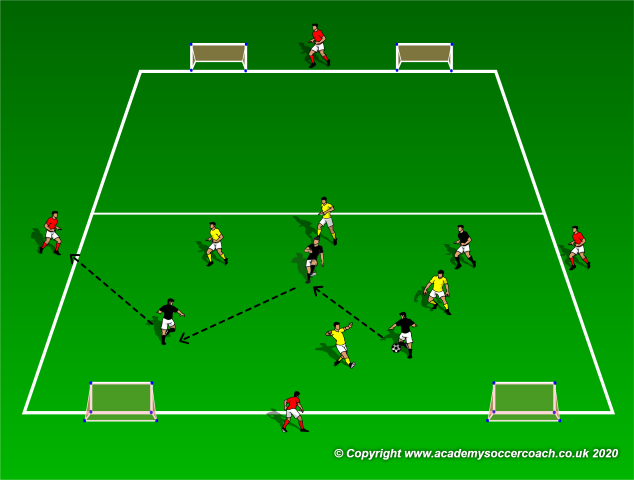
1v1 Scoring Knockout
By Matt Carroll –
While this is something that can definitely be seen as a technical workout, the high level of physical work players will experience will ensure that your player’s in-game physical shape will improve. In this drill, you will want to create a grid appropriate to the number of players available, taking into account the smaller the grid the more chaotic the game will be and the longer players will be stay “in”. On each side of the grid place a pug goal, the smaller the goal the higher level of difficulty and conditioning. Each player should be paired up 1v1 with one player on the ball and the other without.
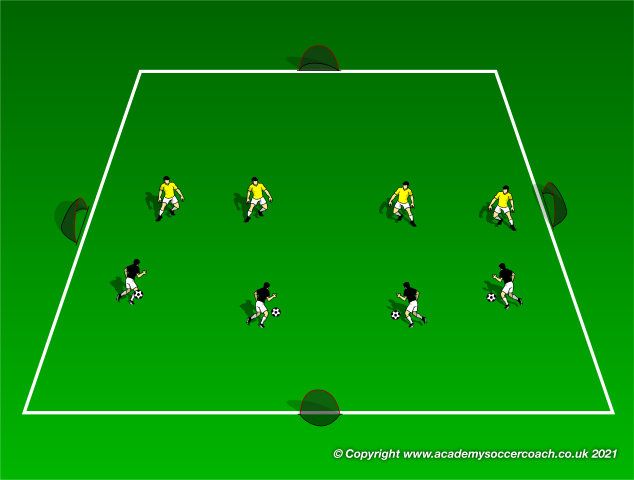
The game starts on the coach’s signal and immediately the player with the ball attempts to score on one of the four goals. The defending player attempts to win the ball and then score themselves. Any ball that goes out of bounds is a turnover and the player that did not touch the ball is allowed to dribble into the grid from wherever the ball initially left the grid. If the player scores they then leave the grid and now get recovery time.
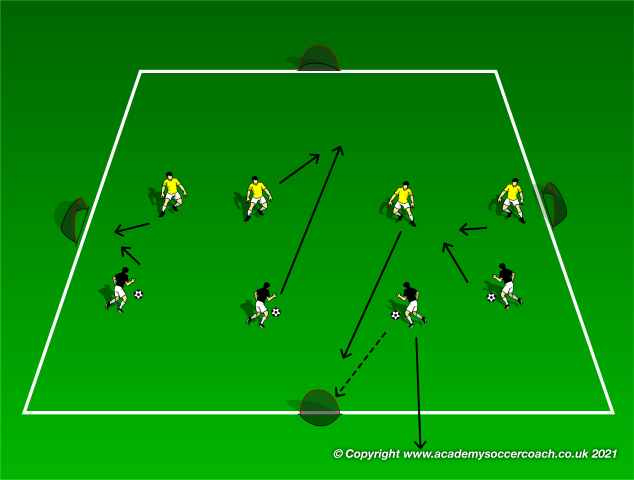
The player that was scored on now needs to find a pair and that pair becomes a triad where the same rules apply as before. If one of the players scores though it goes back to a pair with the player that has been in the group the longest starting with the ball. The game ends when there is only one player left in the grid who has not scored.
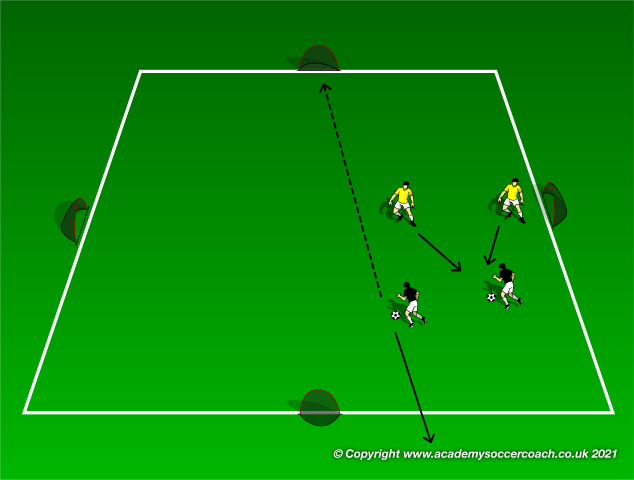
By Matt Carroll

3-2-1 Technique Sprints
By Matt Carroll –
This is a great sprint workout that can be used 2-3 times a week to increase players’ max velocity and improve sprint technique. The key to speed training is to maximize technique and power and to minimize reps so that athletes are able to get to as near as 100% as they can for each repetition. Players should start with the basics, and then more advanced, and game-like, sprints can be utilized.
First, have players line up on the touchline with a cone 10, 20, and 40 yards apart.
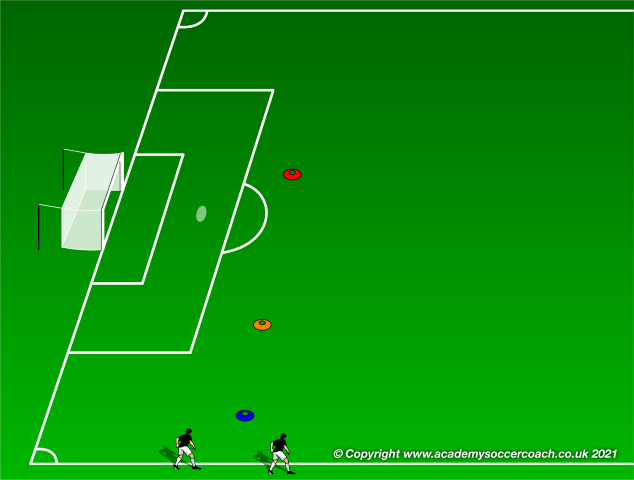
A good starting point is to have your athletes line up with their toes on the line, then have them fall forward. Whichever foot they reach out to catch themselves should then be the foot they drive off of in their sprint. Players should be coached against “rocking” where they initially step backward or rock back before starting their forward motion.
Another point to focus on is to have players “rip” their arms forwards and back at a 90-degree angle with hands reaching forward till they align with their chin, and back till they align with their hip.
The coach should start the drill with some type of starting signal, but it should be made clear to the players that they should go when they are ready, so they can focus on technique, and they should go at full speed. Players should have reps at 10 yards, 2 at 20, and one full 40-yard sprint. As players jog back after their sprint they should focus on slowing their breathing and the next rep should not start until athletes’ breathing has returned to normal. Again, the focus is speed, not fitness.
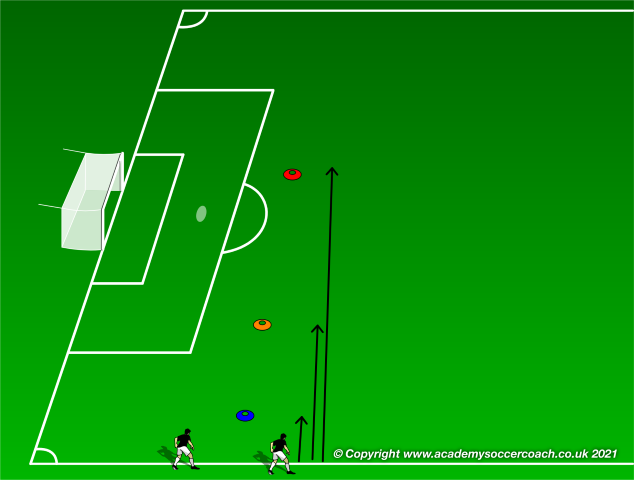
As players’ techniques begin to improve the sprints can move from stationary to situational. For example, players can be told to run diagonally to a coaching stick, then start their sprint once they reach the stick, utilizing the same technique they learned from the stationary start.
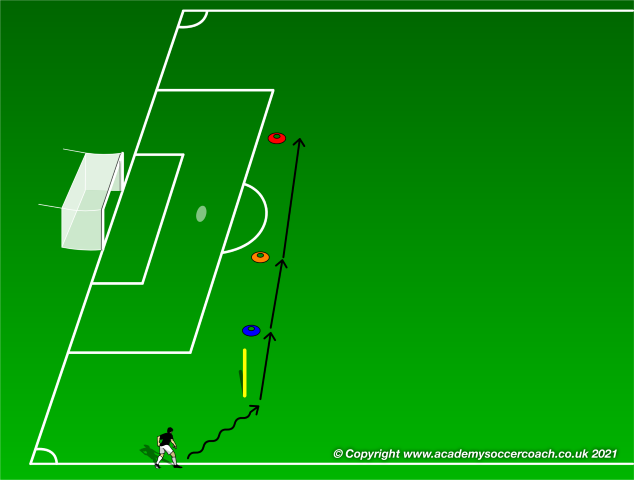
By Matt Carroll
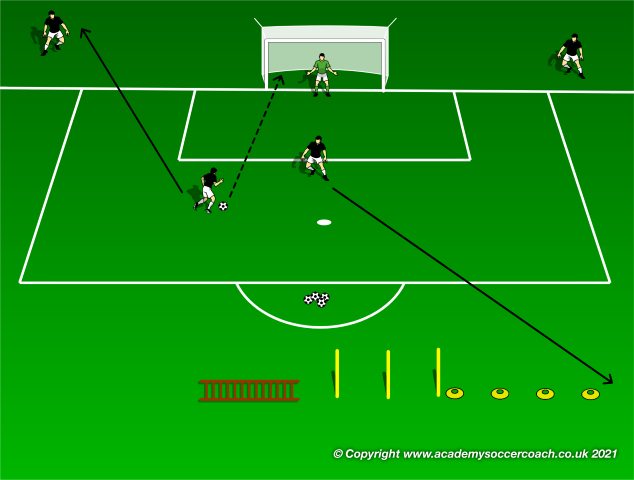
The Angus Drill
By Matt Carroll –
This activity has two parts, one is a competitive game with conditioning elements, the other is a conditioning drill with technical elements. It is a great game to play to improve the soccer-specific fitness of your players, but also the competitive drive of your team.
The game starts off with balls and the coaches at the D. The players line up on the end line at the point of each side of the 18. You can use one goalie, or alternate goalies every turn. Off to the side, away from the 18, there should be some type of age-specific technical/conditioning circuit set up. It should include ball work as well as agility work. This can be whatever the coach desires, but it should be something players will be able to repeat for the length of the entire game. A coach should be designated to this area to instruct, but also to monitor, and possibly limit player’s workloads.
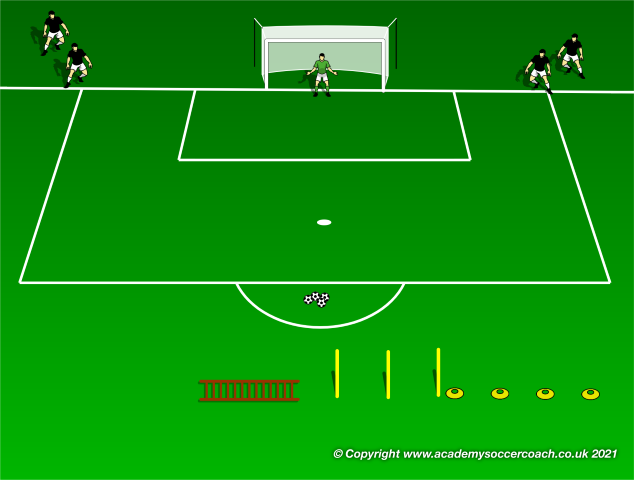
The game starts when the coach throws a ball anywhere into the 18 and the first player in each line then rushes onto the field to attempt to score. If one player is more technically gifted maybe you throw the ball to the less gifted player to challenge the other. Even strength players can have the dropped in the dead center.
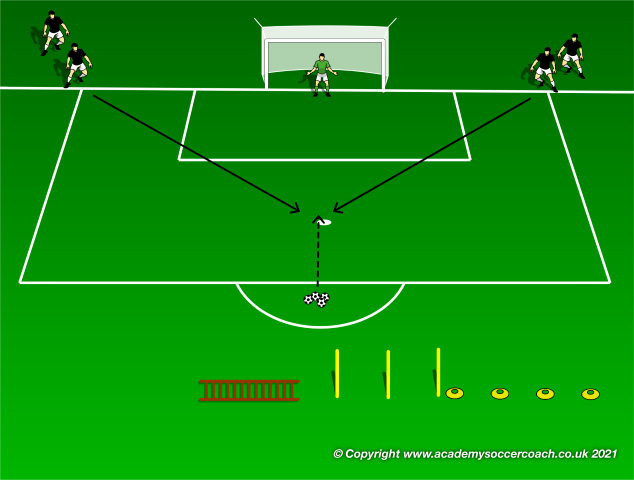
If the ball goes out, either it leaves the 18 or the shot is blocked or saved, both players retreat to the back of the line. You can vary this as well and make it that both players are sent to the conditioning circuit, and then just reset the drill until there is a winner as well. If a goal is scored, the scorer “stays on ”and goes to the back of the line. The loser goes over to the conditioning circuit until there is only one remaining player.

By Matt Carroll
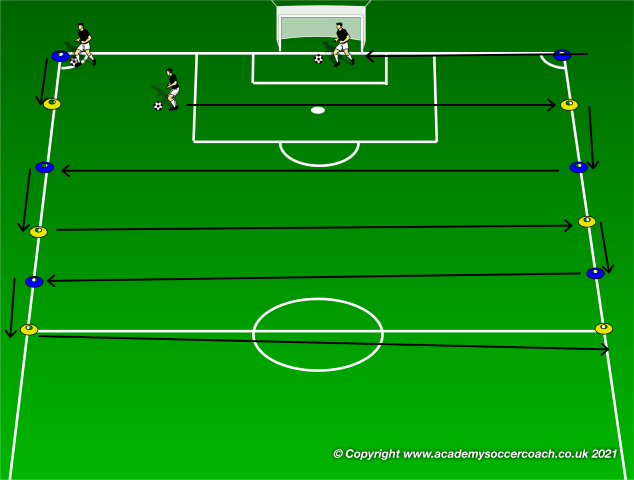
The Michigan Drill
By Matt Carroll –
This is a common football conditioning drill that has been adapted to utilize soccer specific elements so that there is a level of technical work that is included on top of the conditioning work. To set up the drill coaches should start at a corner flag and put a new cone every 5 feet on one touchline until half. On the opposite touchline they should place a cone that is in the identical spot to a cone on the other side. It may help to color code these so every other cone is a different cone.
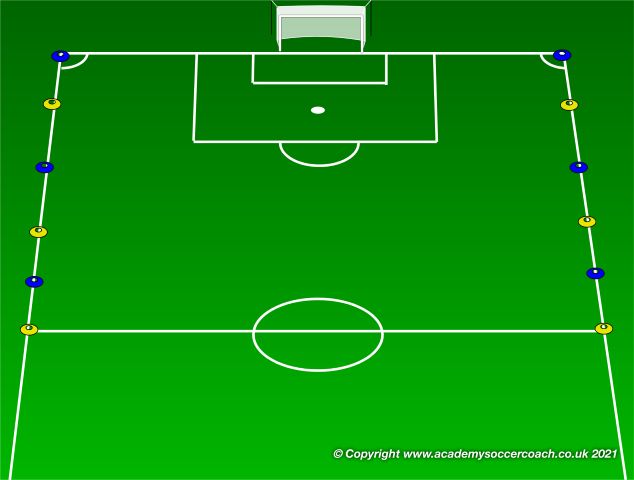
Have players line up at the corner flag with a ball. On the coach’s direction the first player begins to sprint with the ball towards the opposite touchline. When they get about halfway the next player can go.
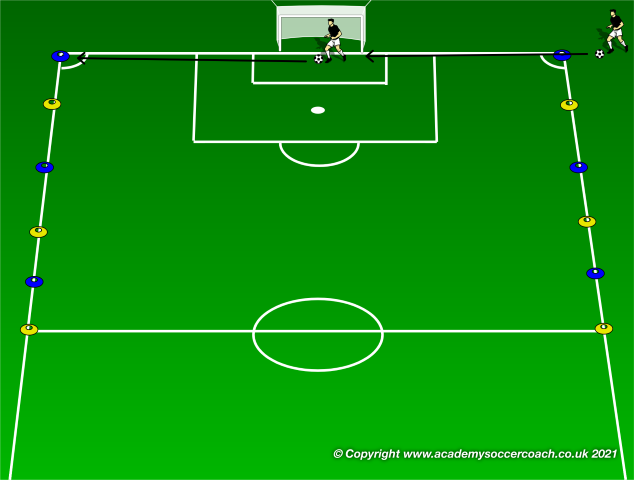
Once the players reach the cone they should roll the ball over with the sole of their foot until they reach the next cone. They then alternate feet, again with the sole, rolling the ball backwards, and backpedaling, until they reach the next cone. Once they reach the cone on the near touchline they again roll the ball over to the next cone and then sprint. Repeating until they have completed every line.

By Matt Carroll
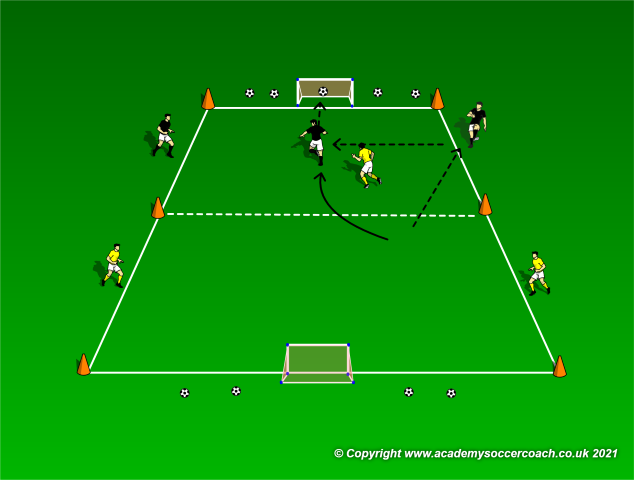
1 Plus 2 v 1 Endurance
By Philip Cauchi
Title of practice: 1+2 v 1 Endurance.
Type of practice: High Intensity Interval.
Age bracket: Under 12 upward.
Area of practice: 15 yards by 10 yards divided into two equal vertical zones.
Aim of the practice: To develop muscular endurance in the duel. The players are required to perform a high number of soccer actions, both on and off-the-ball and both in the attacking and defending phases.
Number of players: Two teams of three players each. One player from each team working and the other two on the perimeter recovering actively.
Workload: Blocks of thirty seconds each with a period of one hundred to one hundred and twenty seconds of recovery in between. The number of blocks vary according to the period of the season we are in and also to the soccer fitness level of the players.
Description of the practice:
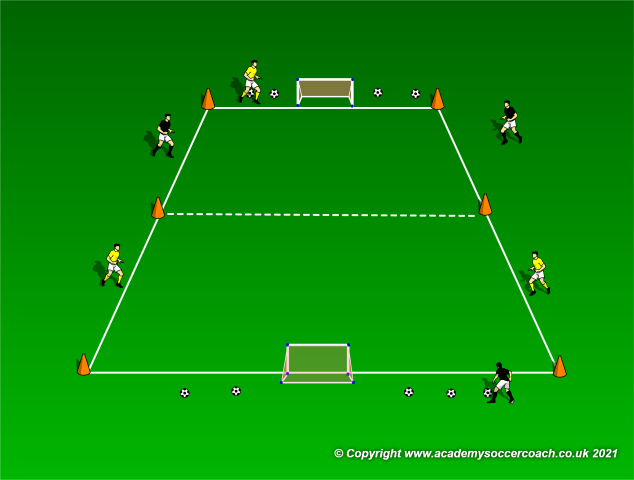
Both the player starting the attack and the defender start from their own goal lines close to the goal they are defending. In the opposing half of the practice area the attacking player has a support player on each side. The support players are the players actively recovering between blocks.
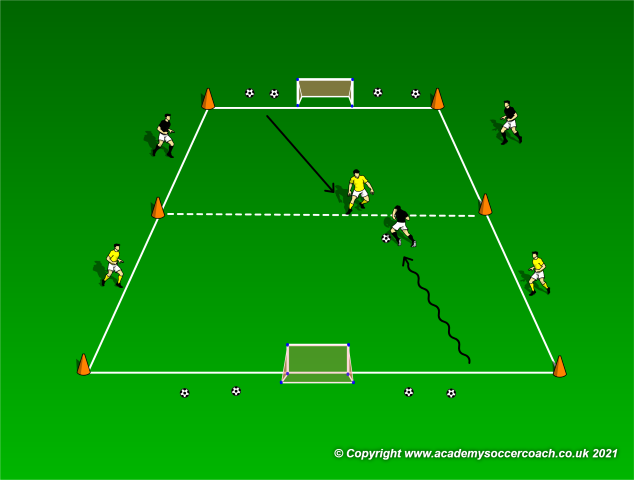
The attacker dribbles the ball forward and can only score from inside the defender’s half of the practice area. Immediately after the attacker starts the attack, the defender becomes active.

The attacker can decide to dribble past the defender or combine with any of the supporting perimeter players to score. Should the defender win the ball she counters on the opposite goal from inside the opponent’s half.
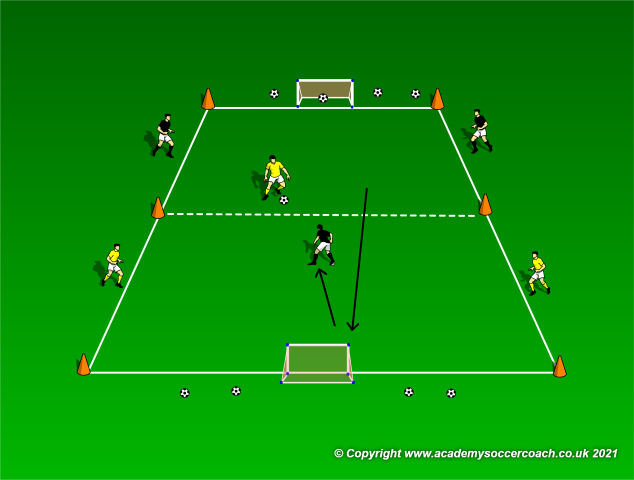
If a goal is scored the defender who suffered the goal sprints back to her goal line to take another ball and initiate the new attack. The attacker now becomes the defender and sprints back to touch her mini goal post to then defend against the new attacker. This procedure also occurs if the ball goes out of play. In this situation the player who made the tackle and won the duel is rewarded by restarting play as described.
Progression 1: Instead of restarting play in the way described above. The player who is now on the attack receives the ball from one of the two teammates on the perimeter (the player should be pre identified before the start of the exercise) to simulate a quick counter attack.
Progression 2: As in progression one but the coach restarts the game by putting another ball in play.
By Philip Cauchi
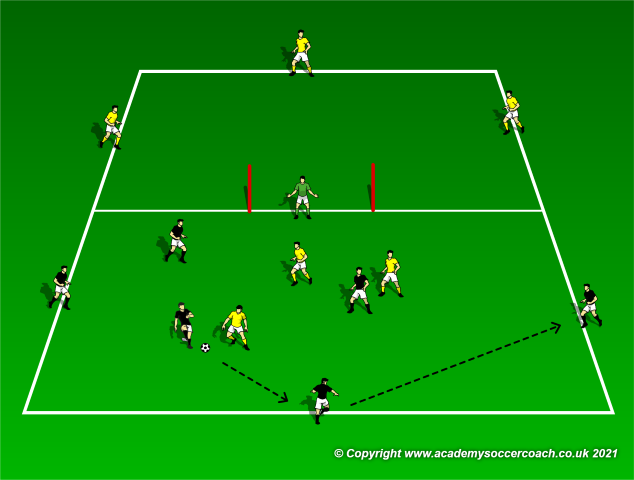
3+3 v 3 Continuous Transition Game
By Philip Cauchi
Title of practice: 3+3 v 3 Continuous Transition Game.
Type of practice: High Intensity Intermittent.
Age bracket: Under 14 upward.
Area of practice: 35 yards in length by 20 yards in width divided into two equal vertical zones. This however depends on the tactical-technical and also the soccer fitness level of the players.
Aim of the practice: For the players to be quick on moments of transition, both negative and positive.
Number of players: Each team has three players inside and three players on the perimeter.
Workload: 6 to 8 blocks of two to four minutes (depending on the level of soccer fitness) each with a recovery period of two to four minutes. During the recovery period the inside players switch their role with the outside players.
Description of the practice:
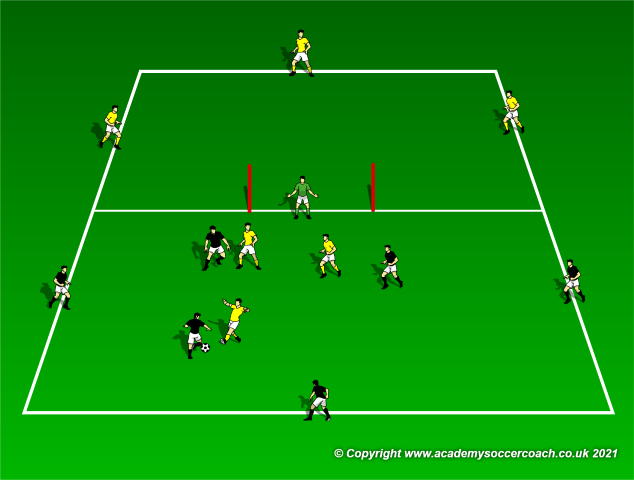
Each team has three players positioned on the perimeter in their own half of the practice area. A central goal marked by poles is guarded by a goalkeeper who is neutral. When playing in their own half of the practice area, the team in possession plays with a numerical advantage of 6v3. Teams can only score from inside their own half.

The team in possession uses the perimeter players to secure possession of the ball and to find the right moment to finish on goal. They can only score from their half of the practice area. The perimeter players may be allowed to score. However, if we want the inside players to work more on getting unmarked and thus also increase the intensity level (tactical-technical, mental, physical and psychosocial) the perimeter players should not be allowed to score. As the load of the perimeter players is low they will be actively recovering. An active recovery (performing light work) allows for a faster recovery than passive recovery (doing nothing). The team without the ball aims to recover the ball and play it to their teammates in their half.
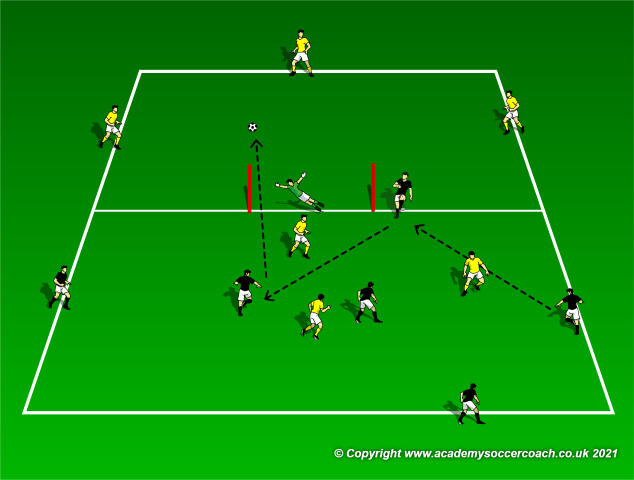
A goal is scored and the ball gets to the opposite half. The other team now has the ball and are on the offensive. This also goes if the ball was shot wide of the goal. The team that scored the goal must quickly react to the change of roles (negative transition). If the team hadn’t scored and the ball was saved by the goalkeeper, he passes the ball to the defending team in the opposite half of the field.
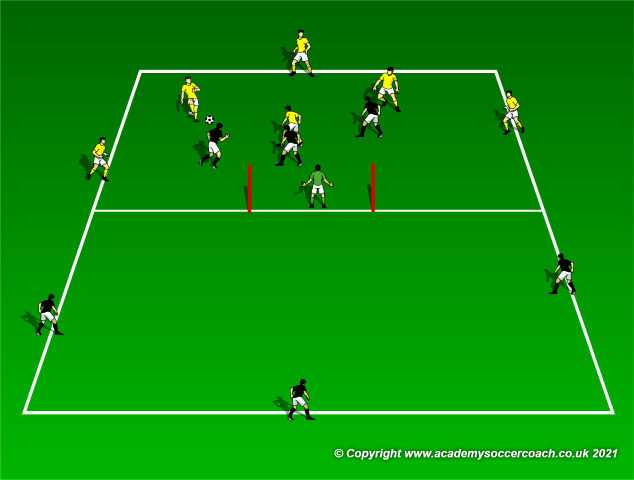
Both teams must quickly move into the opposite half of the pitch. The new team in possession of the ball must have all of its players inside their own half before they are allowed to score. For the team who now has to defend, if their players are not all inside the opponents’ half if a goal is scored, the goal counts double.
By Philip Cauchi
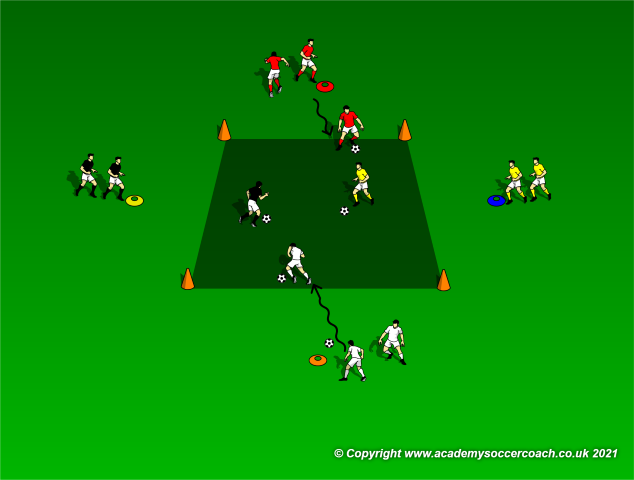
Ball Gladiators Warm Up and Conditioning Game
By Philip Cauchi
Title of practice: Ball Gladiators.
Type of practice: Warm-up
Age bracket: Under 8 to under 13.
Area of practice: 12 yards by 12 yards.
Aim of the practice: The players will be aware of when and how to shield the ball to protect it, play with the head up and continuously assess their surroundings, and also to learn when to time to tackle to dispossess an opponent of the ball.
Number of players: Four groups of three to four players each.
Workload: Continuous play for five minutes with continuous changes of players during the game.
Description of the practice:
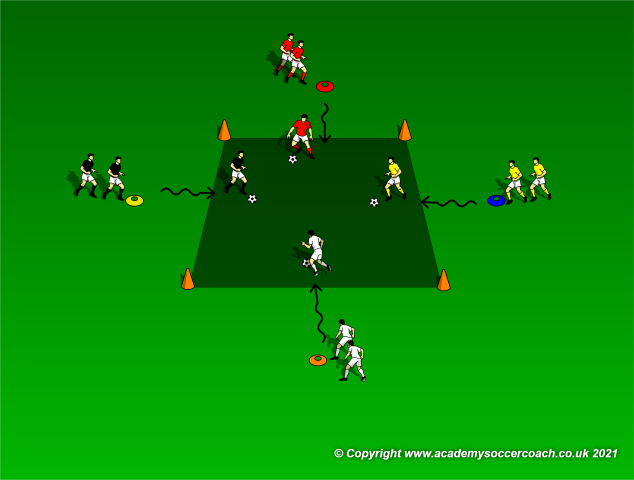
Four groups of players where each group is positioned three yards outside a side of the marked practice area. The first player in line of each group dribbles the ball into the practice area.
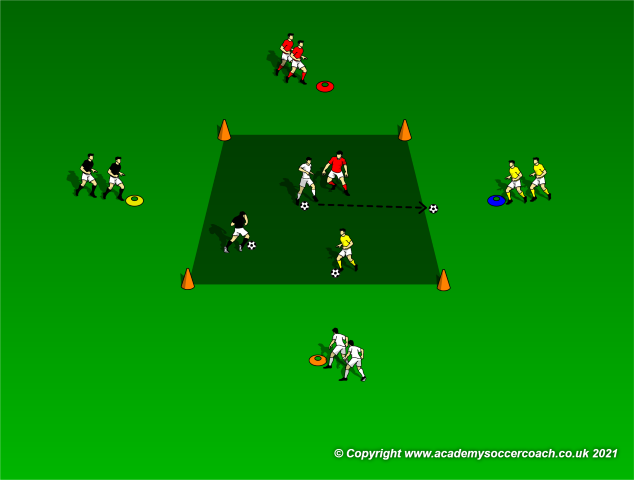
Play is all v all where each player protects her ball and aims to kick any of the opposing three players’ ball out of the area. If successful the player earns a point for her team. As a variation we can also include that the player who had her ball kicked out of the area loses a point for her team. The player who had her ball kicked out of the area cannot kick someone else’s ball. However, the player who kicked her ball can also have her ball kicked out of the area. This forces the players to identify the right moment to tackle any other player’s ball while keeping their ball protected.
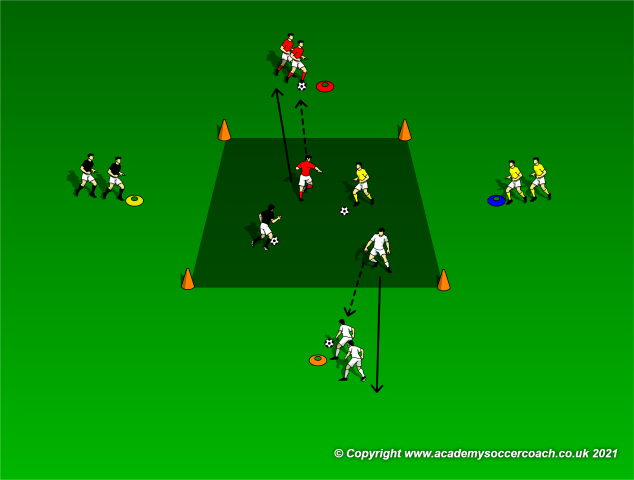
Both the players who kicked the opponent’s ball out of the practice area and the player who had her ball kicked out swap places with the next player in line in their group. This eliminates the risk of having one player staying all the time inside with the ball with her teammates being static for the majority of the practice time.
Should the players remain for more than thirty seconds inside, the coach may shout the letter, number, color, etc of their group to switch with the player next in line. We can also have a rule that if a player stays standing inside without doing anything for thirty seconds or more has a point reduced for her team.

The players next in line of both groups dribble the ball to join the other two competitors.
By Philip Cauchi

Team In Team Out Continuous Play
By Philip Cauchi
Title: Team in – Team out: Continuous play.
Area of practice: 30 yards by 25 yards.
Number of players: Two goalkeepers and twelve outfield players. The outfield players are divided into three groups.
Workload: Continuous play for eight minutes with a rest period of three minutes in between series. Play three of four series depending on the level of the soccer fitness of your players.
Description of the practice:
Two groups start playing against each other as in a normal game. Each group/team attacks one goalpost and defends the opposite. A goalkeeper is assigned to each team. The third team act as neutrals and are positioned on the side lines as shown in the diagram below. When one of the two teams score, they retain the ball and immediately counter on the opposite goalpost. In the meantime the team who were neutral must immediately switch roles with the team that conceded the goal.
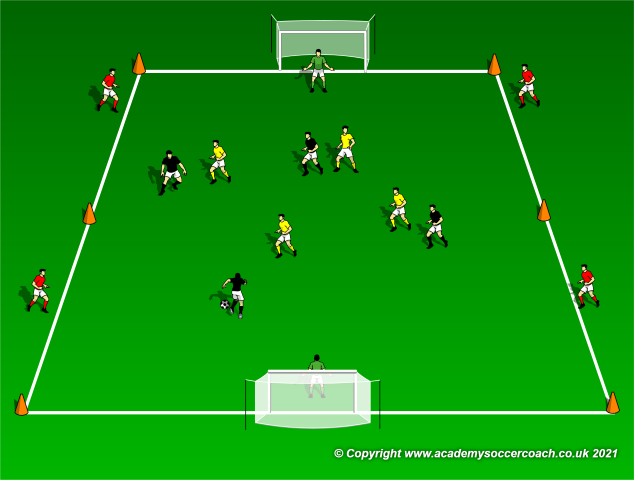
The two teams start the practice as a normal game where they attack one goalpost and defend the opposite. The neutral players on the side lines help the team in possession to secure the ball but are not allowed to score. This forces the players of the team in possession to create and exploit space in order to be able to finish on goal.
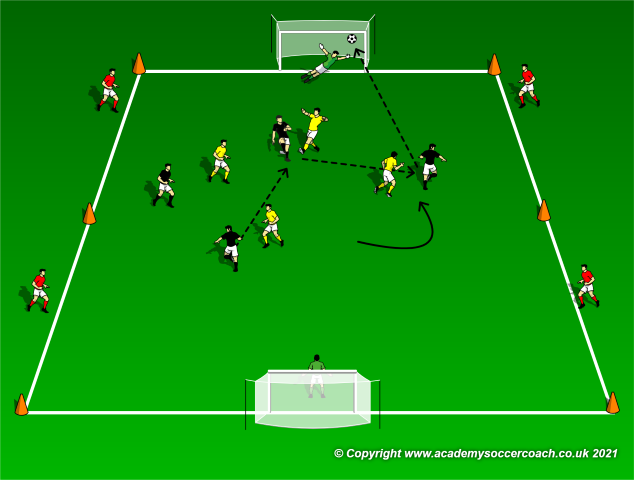
One of the team scores and retains possession of the ball. Immediately the team who suffered the goal switch places with the team who is actively recovering by acting as neutrals on the side lines.
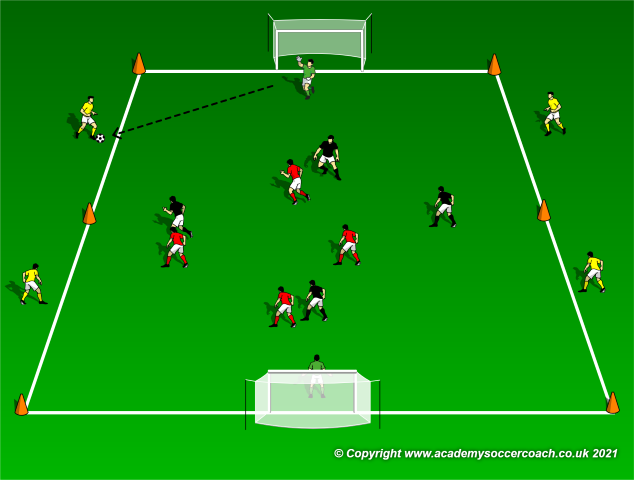
The team that scored attacks in the opposite direction. All the players must quickly react to the change of the situation by adapting their position on the field of play accordingly.
By Philip Cauchi
